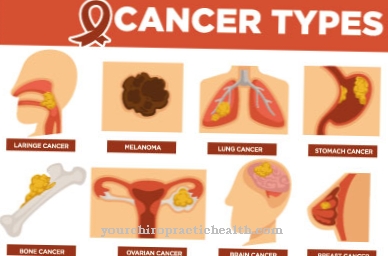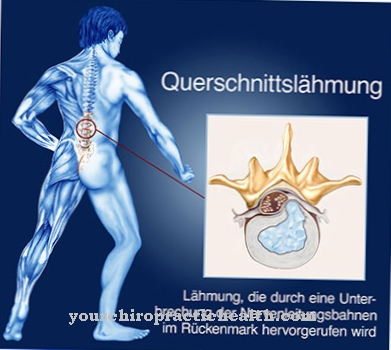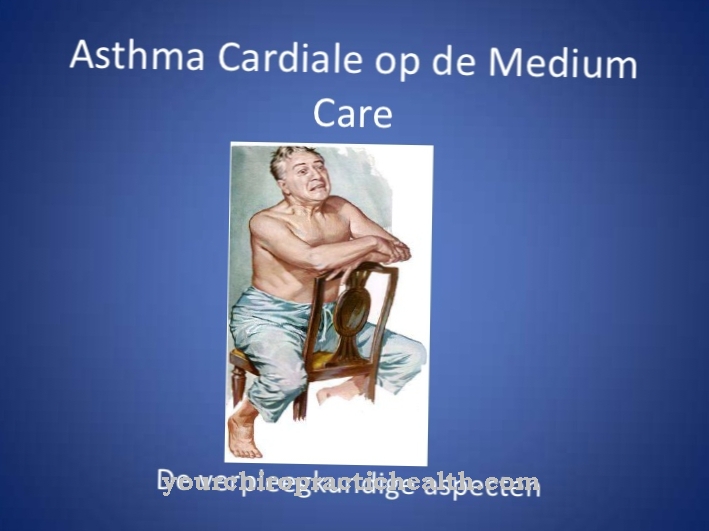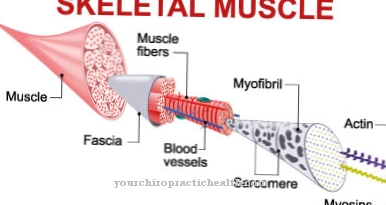Whooping cough (pertussis) is an infectious disease of the bronchi and respiratory tract caused by bacteria. It is triggered by the Bordetella pertussis Balterium. Although whooping cough is generally known as a childhood disease, adolescents and adults are also becoming increasingly ill. There is a vaccination against whooping cough.
What is whooping cough?

© Henrie - stock.adobe.com
Whooping cough (sticky cough) or medical Pertussis is a highly contagious infectious disease caused by bacteria that infest the patient's nose, throat, windpipe and lungs. As the name suggests, whooping cough manifests itself in convulsive coughing attacks, which are followed by gasping for breath (shortness of breath, abnormal breathing noises).
The disease is very protracted (several weeks to months) and is fatal in one in a thousand patients. Infants are particularly at risk in their first six months, as they can suddenly stop breathing.
Whooping cough is by no means just a childhood disease. People of all ages can be affected. After surviving the illness, there is immunity for about four to twelve years. Subsequent infection cannot be ruled out. Immunity after vaccination against whooping cough is similarly long.
causes
The bacterium Bordetella pertussis as the causative agent and cause of the Whooping cough spreads through droplet infection. When speaking, coughing or sneezing, the pathogens get into the air and are inhaled by people in the vicinity. This is how the bacteria get into the airways, where they settle in the mucous membranes.
Here they multiply and have their own metabolism. The bacteria produce various protein substances, some of which as toxins (poisons) destroy the mucous membranes and weaken the immune system. They also damage the surrounding tissue and thus cause the typical symptoms of the disease.
Whooping cough pathogens are particularly infectious. More than three quarters of the people who come into contact with them fall ill. In addition to Bordetella pertussis, Bordetella parapertussis can also lead to the clinical picture of whooping cough, but in most cases these infections are shorter and less violent or even silent.
Symptoms, ailments & signs
With whooping cough, the symptoms and discomfort often persist for weeks or even months. The symptoms appear in three stages. In the catarrhal stage, symptoms are similar to the common cold. Those affected suffer from sneezing, runny nose, coughing and hoarseness. There is also a slight fever.
Sometimes conjunctivitis is added, which, like the other signs, lasts for a week or two. In the second stage, whooping cough proper develops. The sick suffer from severe coughing fits with wheezing when inhaling. This stage lasts for three to six weeks, with the coughing fits only disappearing after a month. The coughing fits occur particularly in children and adolescents.
They can be recognized by the fact that the patient coughs several times with his tongue stretched out and then breathes in panting. Typical is the gasping sound, which is accompanied by a tough, glassy sputum. Many people vomit or have a fever. Symptoms mainly occur at night and in the morning.
Depending on the age, other symptoms may occur, such as respiratory arrest in infants and a dry cough in adults. In the last stage the symptoms slowly subside. After six to ten weeks, whooping cough is over.
Course of disease
Usually the Whooping Cough Disease in three stages, which are characterized by different symptoms:
The first, cold-like stage (catarrhal stage) lasts about one to two weeks. Symptoms resemble a cold, such as sneezing, runny nose, slight cough, hoarseness or a slight fever. The greatest risk of infection already exists in this phase.
The second stage is the seizure stage (convulsive stage), which lasts for two to six weeks. This is where the typical symptoms of whooping cough appear: Strong, convulsive coughing attacks with the tongue sticking out are accompanied by wheezing inhalation. The coughing fits are repeated at short intervals and often end in gagging and vomiting. An increase in cough attacks occurs at night and after exercise such as exercise or stress.
Whooping cough is also threatening because of serious accompanying illnesses such as pneumonia, otitis media or cerebral hemorrhage. The stage decrementi is the last phase of the disease in which the symptoms slowly become weaker and weaker. If left untreated, it lasts six to ten weeks.
Complications
In the decrementi stage the symptoms gradually decrease, but here it is usually too late for causal therapy for whooping cough. Accordingly, antibiotics can still be used, which in this last phase limits the course of the disease to a length of up to six weeks. If left untreated, the remaining cough and spasmodic coughing attacks can drag on for another ten weeks.
In babies in particular, pertussis leads to dangerous swelling of the airways more quickly and consequently to pauses in breathing. The longer the body is affected by the whooping cough, the more likely the symptoms will be stronger. Secondary infections of the lungs (15 to 20 percent of cases) and middle ear are common. Seizures, which lead to a temporary insufficient supply of oxygen to the brain, affect up to four percent of those affected. Any consequential damage here depends on the duration of the oxygen deficiency.
In 0.5 percent of cases, the brain becomes involved due to the toxins produced by the pathogens causing pertussis. Such encephalopathy always leaves tissue damage. The consequential damages range from motor restrictions to permanent sensory difficulties and can also impair cognitive performance. Younger people are often more severely affected than older people. One in a thousand infected people dies of the disease.
You can find your medication here
➔ Medicines against coughs and coldsWhen should you go to the doctor?
If the classic whooping cough symptoms persist for more than a week, a doctor should be consulted. Treatment for whooping cough is essential to avoid serious complications. For this reason, a doctor should be called in as soon as the first signs of illness are seen, who can clarify the symptoms and, if necessary, treat them directly on site. If there is a high fever or shortness of breath, it is best to consult a doctor on the same day. If you have circulatory problems, a visit to the hospital is indicated. The sick person should get examined immediately and make sure that the whooping cough is not caused by a serious illness.
At the latest when the whooping cough significantly affects the well-being or other health problems result, the complaints must be taken to the doctor. Neurological deficits indicate brain involvement and must be treated immediately in a clinic. Children, the elderly, the sick and pregnant women should always have whooping cough examined by a doctor in order to avoid complications. In addition to the family doctor, the ENT doctor or a pulmonologist can also be consulted.
Treatment & Therapy
The course of the disease at whooping cough can only be moderated and shortened if antibiotic therapy is started in good time, i.e. during the catarrhal or early convulsive stage. But the administration of antibiotics also makes sense at a later point in time, as this breaks the chain of infection.
Infants suffering from whooping cough have to go to the hospital because they are often unable to cough up the resulting mucus on their own. In addition to drug therapy, simple measures can alleviate the symptoms: a quiet environment, plenty of fluids and many small meals are important general measures. Hanging wet towels in the bedroom can help reduce coughing fits at night.
Outlook & forecast
Whooping cough usually results from a bacterial infection. For the affected person, an existing whooping cough is often a very uncomfortable affair, as whooping cough is very difficult to cough up. It is also a very dry cough that should usually be treated with medication. If the affected person decides in favor of such a treatment, antibacterial drugs can be used to bring about a rapid improvement or complete healing. After two to three days, the cough should slowly subside and the resulting sore throat should also improve.
If the person concerned does not seek medical or drug treatment for an existing whooping cough, considerable complications can be expected. The intensity of the whooping cough will worsen significantly, making medical treatment inevitable. As soon as the first signs of worsening whooping cough can be seen, a visit to the doctor should not be put off on the back burner. With an appropriate treatment, an existing whooping cough can be effectively fought so that a complete and prompt healing can take place.
If whooping cough does not improve after a few days, drug treatment should be resorted to. This can avoid complications.
Aftercare
The symptoms of whooping cough persist for a long time even after antibiotic therapy is completed. This is due to the damaged mucous membranes and cilia in the bronchi as well as constant irritation of the lung tissue by bacterial toxins, which are only gradually broken down by the body. Follow-up care therefore focuses on measures to restore the mucous membranes; also to prevent subsequent infections of the weakened airways with other pathogens.
Regular inhalations with hot water and a few teaspoons of sea salt help the damaged bronchial tubes to regenerate and also alleviate the often remaining dry cough. The addition of dried thyme to the inhalation can also support the healing of inflamed tissue in the bronchi and the removal of toxins. Increasing the humidity to 40 to 50 percent in the sleeping area, for example by using a humidifier or boiling water, is also helpful so that the night sleep necessary for healing is not interrupted by coughing fits.
Even after surviving an infection, cured patients can become infected again with the pathogen unnoticed after some time and thus infect other people, especially infants and small children. As soon as the symptoms have completely disappeared, the last follow-up measure should therefore be to have your own vaccination protection checked by a doctor and, if necessary, refreshed.
You can do that yourself
Whooping cough does not necessarily require medical treatment. Some self-help measures and resources from the household and nature are just as effective as drugs from the pharmacy.
Basically, the following applies to all those affected: Drink a lot. Classic herbal teas, tap water or mild fruit juices are recommended. In the first few days, your diet should consist of small, light meals such as soup or baby food. Bed rest is also important. The sick person should sleep a lot - preferably in a warm environment (up to 21 ° C) with high humidity.
In addition, various home remedies can alleviate the symptoms of pertussis.For example, inhaling hot water with sea salt or chamomile flowers has proven itself. An effective home remedy is a brew of sour apple must with sugar and fennel, which is best taken in sips. Homeopathy recommends the preparations Belladonna, Carbo vegetabilis and Ledum palustre, among others.
If the symptoms have not subsided after a few days, a visit to the doctor is recommended. With infants and young children, whooping cough should always be seen by the pediatrician. The doctor can give further tips and measures with the help of which the pertussis can be cured quickly.




.jpg)






















